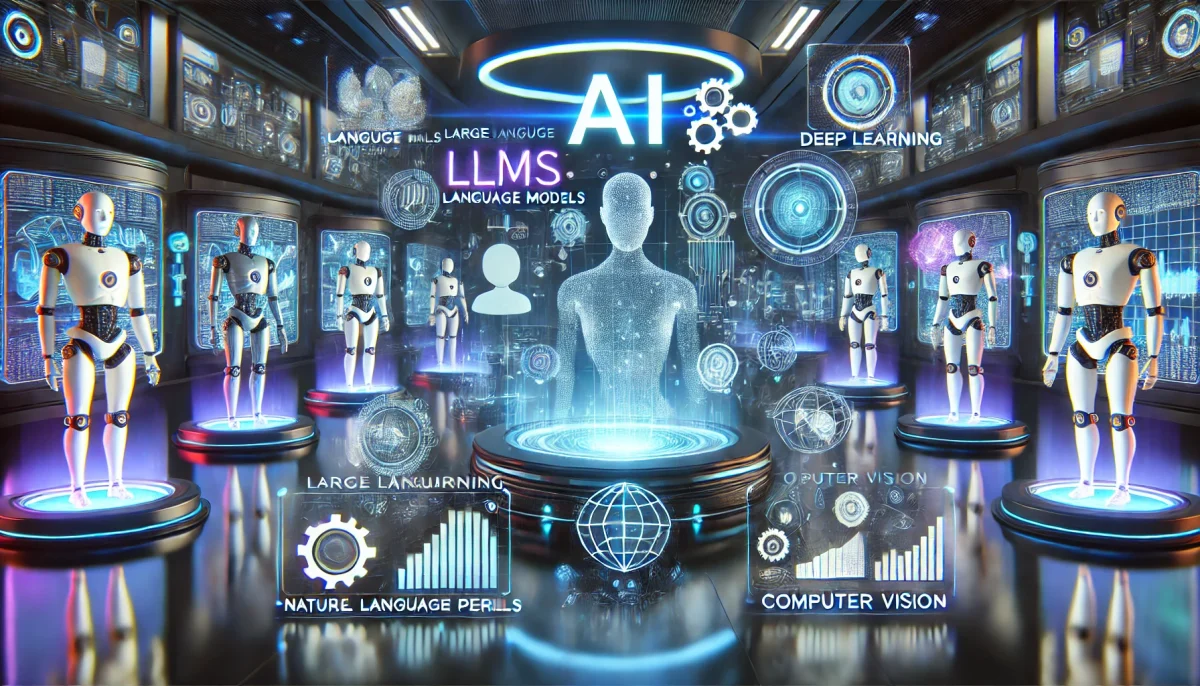Artificial Intelligence (AI) is transforming the world as we know it, enabling machines to perform tasks that once required human intelligence. From understanding human language to recognizing images and making decisions, AI technologies are becoming increasingly sophisticated. In this article, we’ll explore some of the most important AI technologies, including Large Language Models (LLMs), Machine Learning (ML), Deep Learning (DL), Natural Language Processing (NLP), Computer Vision, Robotics, and Reinforcement Learning (RL). Each of these technologies plays a unique role in advancing AI, and together, they are shaping the future of industries and everyday life.
1. Large Language Models (LLMs): The Power of Language AI
What Are LLMs?
Large Language Models (LLMs) are a type of AI model designed to understand, generate, and work with human language. They are trained on vast amounts of text data, including books, websites, and conversations, enabling them to perform tasks like answering questions, writing content, translating languages, and even coding.
How Do LLMs Work?
LLMs use a neural network architecture called Transformers, which allows them to process entire sentences or paragraphs at once, understand context, and predict the next word in a sequence. The more data an LLM is trained on, the better it becomes at generating human-like text.
Examples and Use Cases
- Examples: ChatGPT, Google’s Gemini, Meta’s LLaMA, Claude by Anthropic.
- Use Cases: Writing essays, summarizing documents, creating chatbots, assisting with coding, and translating languages.
Limitations
While LLMs are powerful, they can sometimes generate incorrect or biased information, as they rely solely on patterns in their training data rather than true understanding.
2. Machine Learning (ML): The Foundation of AI
What Is Machine Learning?
Machine Learning (ML) is a subset of AI that enables systems to learn from data and improve over time without being explicitly programmed. Instead of following rigid rules, ML algorithms identify patterns in data to make predictions or decisions.
Types of Machine Learning
- Supervised Learning: The model learns from labeled data (e.g., predicting house prices).
- Unsupervised Learning: The model finds patterns in unlabeled data (e.g., customer segmentation).
- Reinforcement Learning: The model learns by interacting with an environment and receiving rewards or penalties (e.g., game-playing AIs).
Applications
- Predicting stock prices.
- Detecting spam emails.
- Facial recognition.
3. Deep Learning (DL): The Brain Behind Modern AI
What Is Deep Learning?
Deep Learning (DL) is a subset of ML that uses artificial neural networks to learn complex patterns in large datasets. These networks are inspired by the human brain and consist of layers of interconnected nodes.
How Does DL Work?
DL models process data through multiple layers, extracting features and making predictions. For example, a Convolutional Neural Network (CNN) can analyze images to recognize objects or faces.
Applications
- Self-driving cars.
- Voice assistants like Alexa and Siri.
- Image and speech recognition.
4. Natural Language Processing (NLP): Bridging Humans and Machines
What Is NLP?
Natural Language Processing (NLP) is a field of AI focused on enabling computers to understand, interpret, and generate human language. It combines linguistics, computer science, and ML to make language usable by machines.
Key Techniques
- Tokenization: Breaking text into words or phrases.
- Sentiment Analysis: Detecting emotions in text.
- Machine Translation: Translating languages (e.g., Google Translate).
Applications
- Chatbots.
- Voice assistants.
- Analyzing customer reviews.
5. Computer Vision: Teaching Machines to See
What Is Computer Vision?
Computer Vision (CV) is a field of AI that enables machines to interpret and understand visual data, such as images and videos. It allows computers to recognize objects, detect faces, and even describe scenes.
How Does CV Work?
CV systems use techniques like image classification, object detection, and image segmentation to analyze visual data. Deep learning models, particularly CNNs, are often used for these tasks.
Applications
- Facial recognition in smartphones.
- Self-driving cars detecting obstacles.
- Medical imaging for disease diagnosis.
6. Robotics: Intelligent Machines in Action
What Is Robotics?
Robotics is the field of designing, building, and programming robots—machines that can sense their environment, make decisions, and perform tasks autonomously or semi-autonomously.
Key Components
- Sensors: Allow robots to perceive their surroundings.
- Actuators: Enable movement (e.g., motors, arms).
- Controllers: The robot’s “brain” for decision-making.
Applications
- Industrial robots in manufacturing.
- Service robots like vacuum cleaners.
- Exploration robots in space or underwater.
7. Reinforcement Learning (RL): Learning Through Trial and Error
What Is Reinforcement Learning?
Reinforcement Learning (RL) is a type of ML where an agent learns to make decisions by interacting with an environment. The agent receives rewards for good actions and penalties for bad ones, aiming to maximize its total reward over time.
How Does RL Work?
The agent explores its environment, takes actions, and learns from the feedback it receives. Over time, it develops a strategy (policy) to achieve its goals.
Applications
- Game-playing AIs like AlphaGo.
- Training robots to walk or grasp objects.
- Optimizing resource management in industries.
AI technologies like LLMs, ML, DL, NLP, Computer Vision, Robotics, and RL are revolutionizing industries and everyday life. From chatbots that understand human language to self-driving cars that navigate complex environments, these technologies are making machines smarter and more capable than ever before.
As AI continues to evolve, we can expect even more breakthroughs, such as personalized AI assistants, smarter robots, and AI systems that can collaborate creatively with humans. However, it’s important to address challenges like bias, privacy concerns, and ethical considerations to ensure these technologies are used responsibly.
Whether you’re a student, developer, or simply curious about AI, understanding these key technologies is essential to staying informed and prepared for the future. AI is not just a buzzword—it’s a transformative force that’s reshaping the world as we know it.








